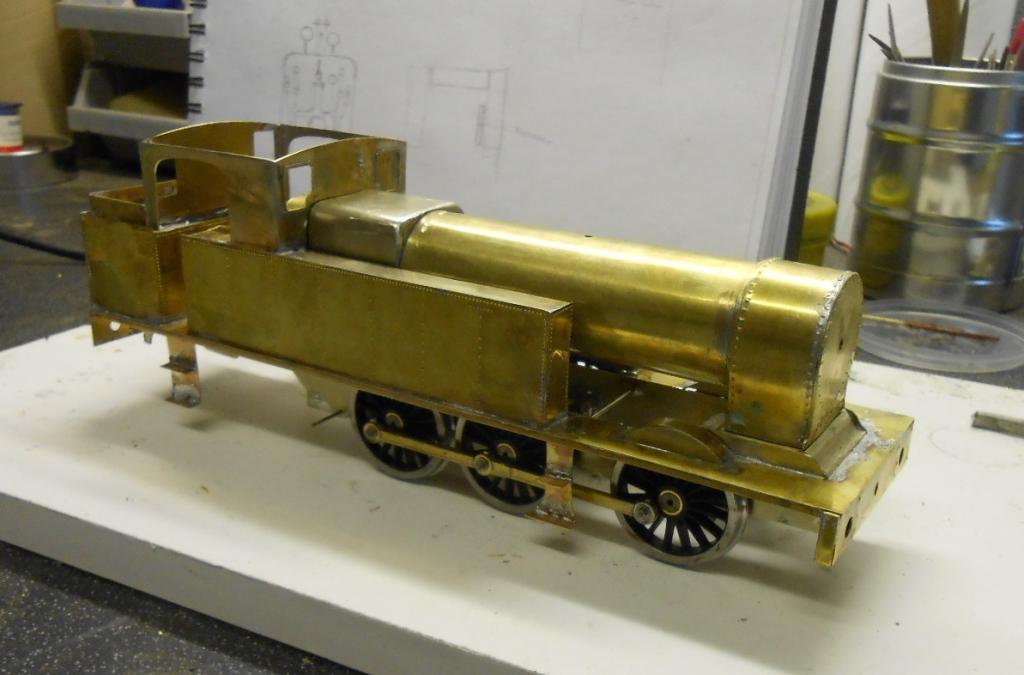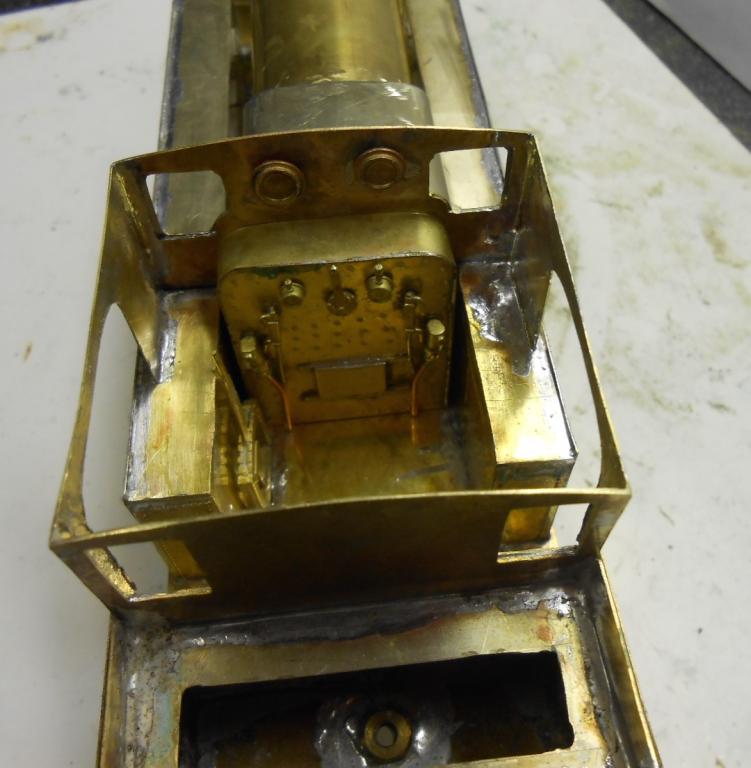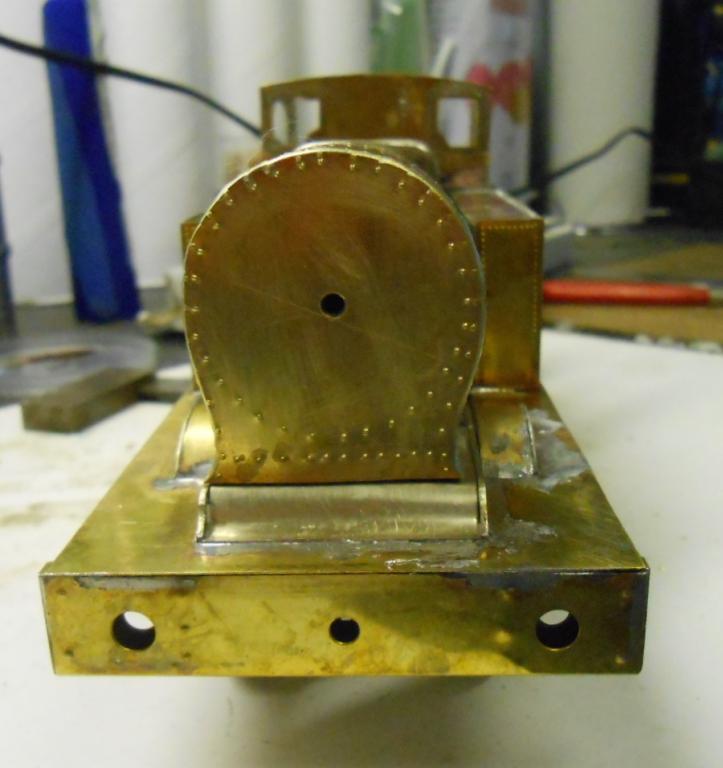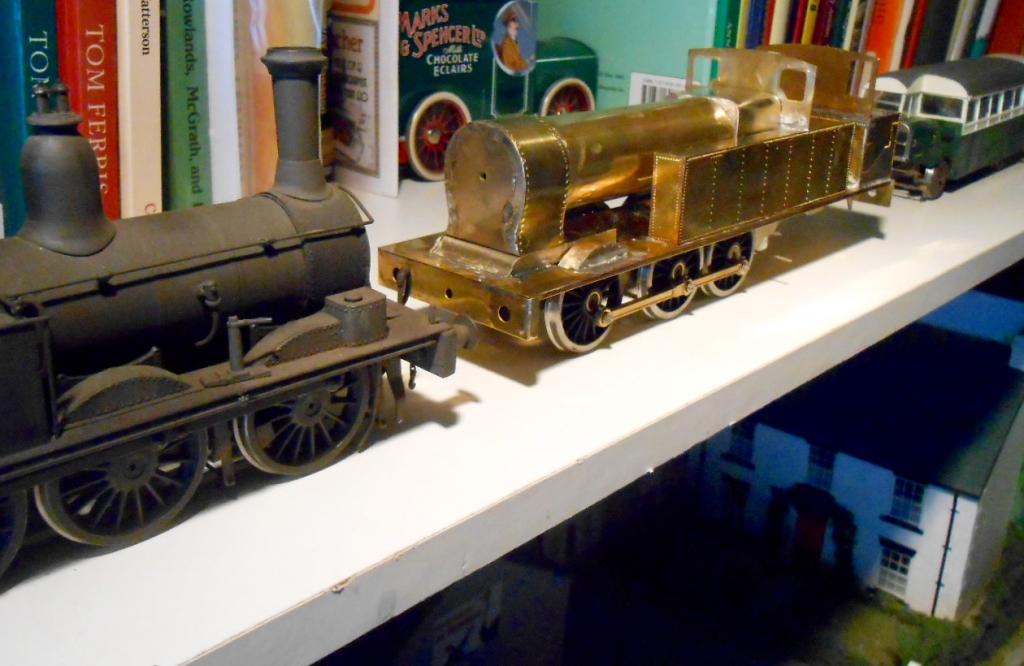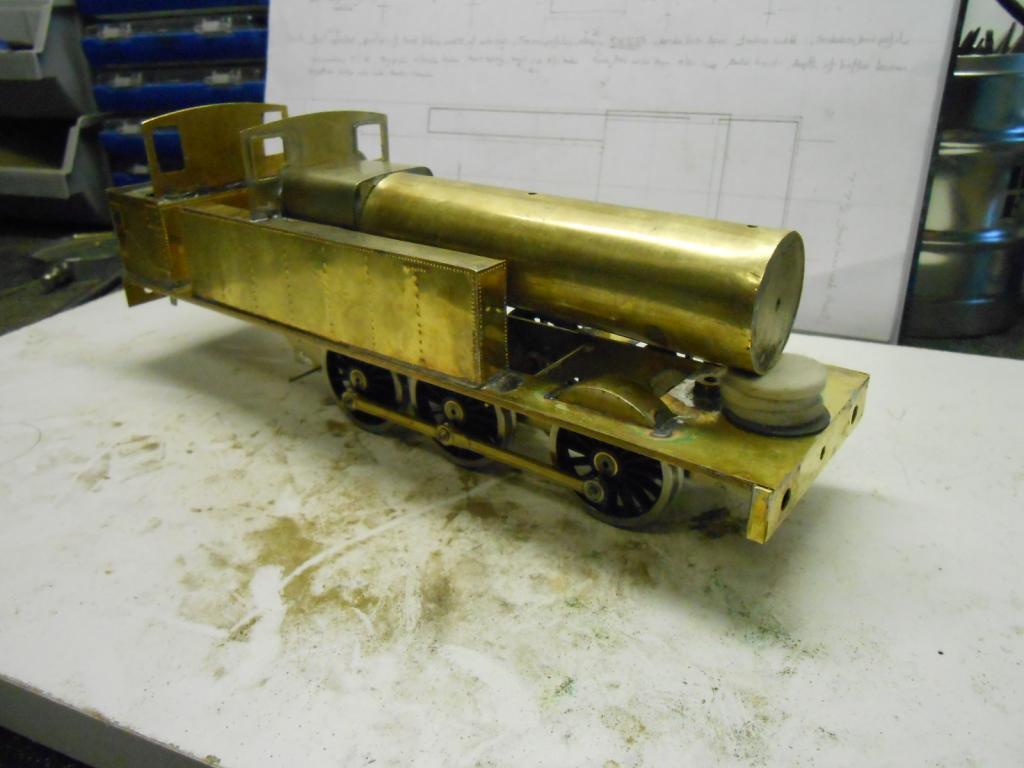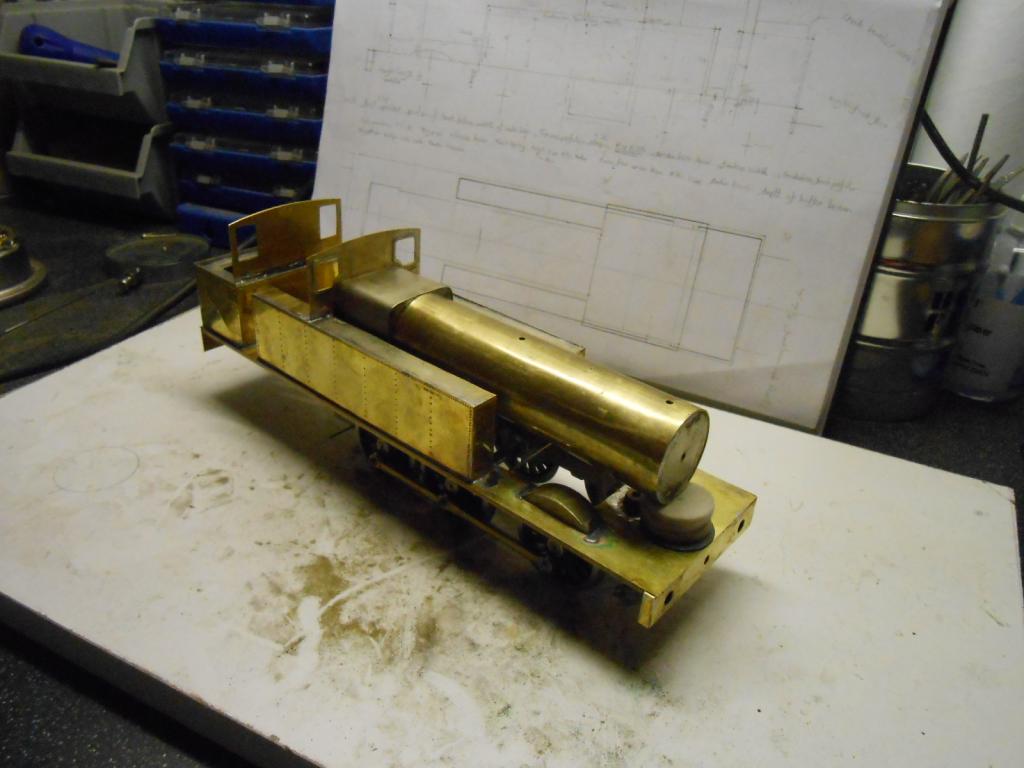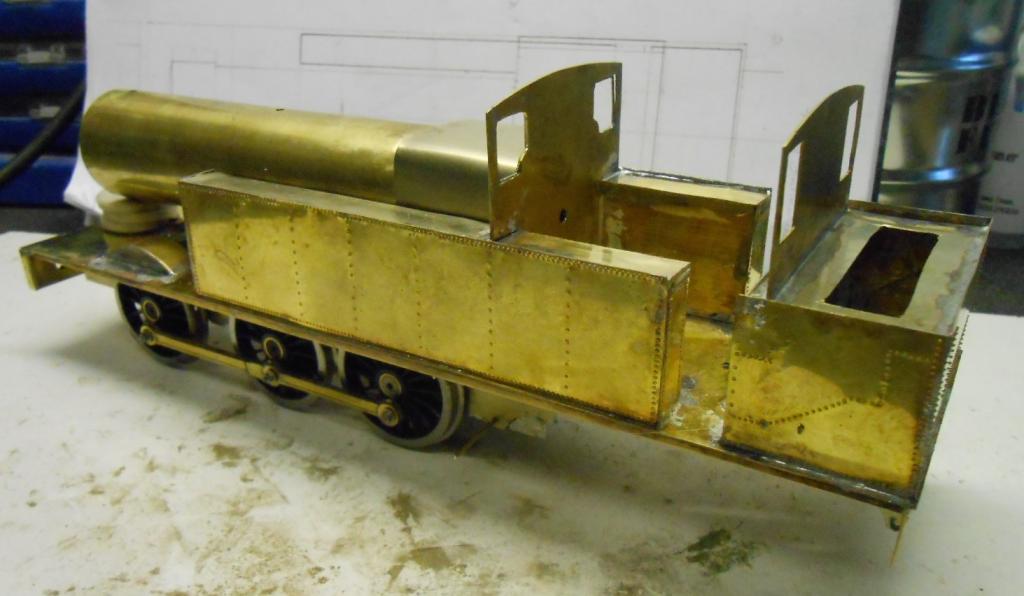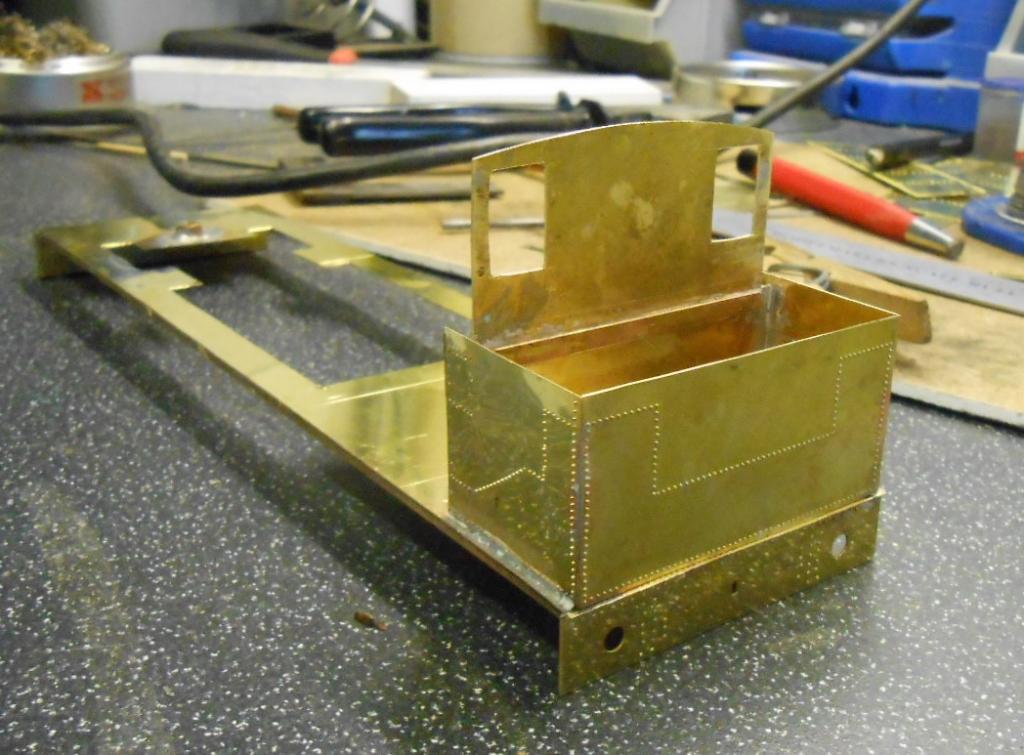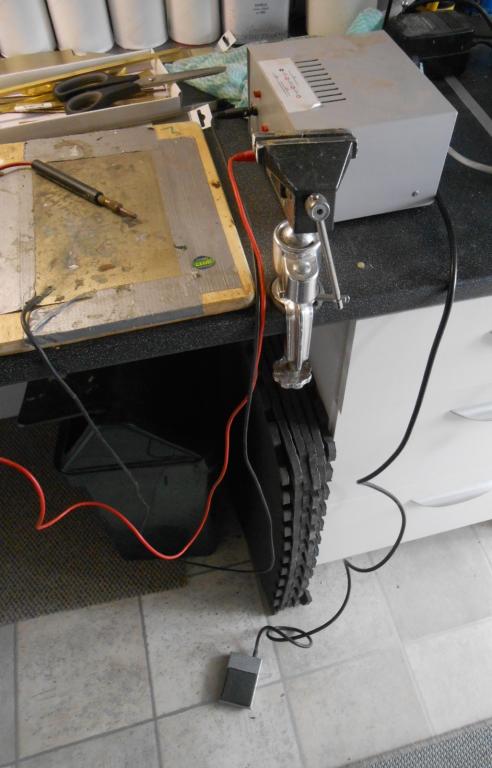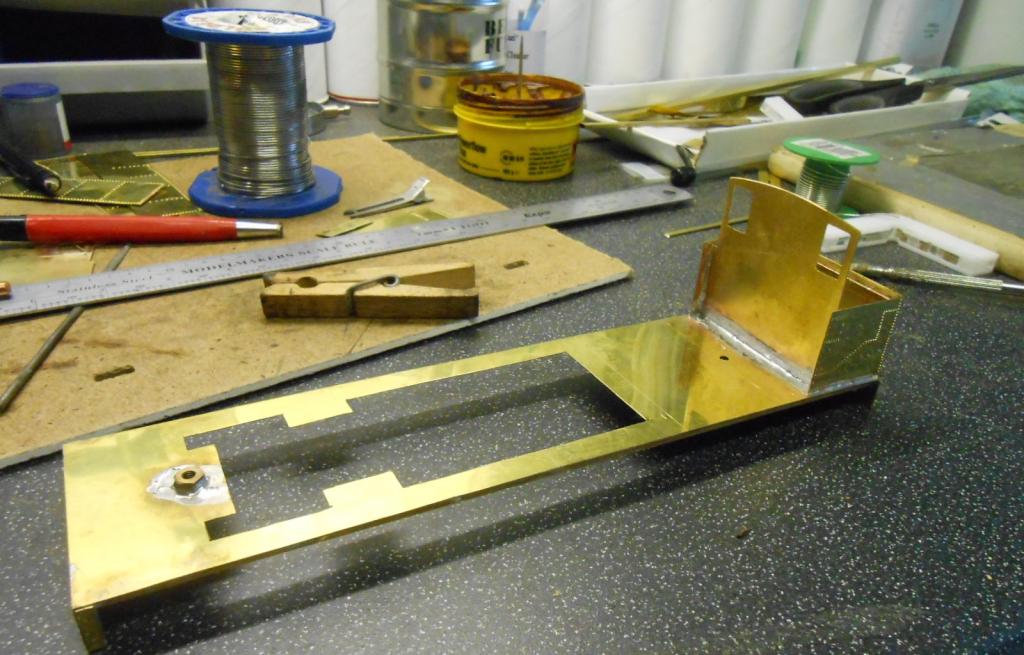
David Holman
Members-
Posts
4,343 -
Joined
-
Last visited
-
Days Won
117
Content Type
Profiles
Forums
Events
Gallery
Blogs
Store
Community Map
Everything posted by David Holman
-
There is a growing sense of delicacy and subtleness to your work, Nelson. The change to three link couplings certainly helps, but there is real finesse in that wagon - sharp lines, no evidence of glue/solvent. Stands up for itself even before it is painted. Proper job.
-
Since unloading the layout after Beckenham, have had two decent day's worth of modelling time. First up was the smokebox front. Picture shows the second attempt, though still not sure the rivets are right - the outer ring is a bit too close to the edge for comfort... It looks off centre too, but fear not, as it is not fixed down yet. A small job was tidying up the rear edge of the upper frames, so they match the profile of the splashers, likewise rounding off the front corners of the Belpaire firebox. Slightly more involved was the cab and bunker area. Began by adding the upper bunker sides [10 thou brass, as usual], then cut out a pair of blanks for the cab sides. These were soldered together before the shape was cut & filed to what I hope is a decent profile. Fiddliest of all were the four steps. Simple in shape, but the riveted strips above each step, made soldering tricky, so glad when these were done. Lastly, in this burst of activity, was the 'back head' [firebox rear]. Cut a sheet of thicker brass to the same profile as the footplate section, then marked out where the main controls would be. Used pictures from the Web to give an impression, but no idea if accurate for a Large Tank. The Tyrconnel G2 helped too - being a Beyer Peacock loco, as did Hazlewood. Des at Studio Scale Models was very kind in selling me a pack of castings from the Small Tank kit. These included water gauge glasses, injectors, pressure gauges, regulator & reversing levers, plus a brake standard. Also on the sprues were a smokebox door wheel and a couple of other useful items, so many thanks, Des! The basic structure of the loco is now complete, apart from the bogie, so next step will be a thorough clean up before I start adding the details. As you can see, i am not the neatest when it comes to soldering, so seems a good idea to get things tidied up before bits like beading, and castings go on. If anyone can tell me what the correct chimney and dome for a Large Tank in the 1950s should be and more particular where I can buy them, I will be very grateful.
-
Arigna Town Exhibition Blog
David Holman commented on David Holman's blog entry in David Holman's Blog
Enjoyable day at Beckenham, marred only by the fact that the church was cold and it rained while loading up afterwards. Thankfully for the latter, the Yeti's tailgate is a good umbrella and could park right next to the entrance. Gravetts very good company & Pempoul is still as stunning as ever. Ariana ran well, though the turntable mechanism is starting to slip. Traced it to the polystyrene tube that connects the crank hand to the drive shaft. Makes the former removable for transport. Hence either need to find some 3mm i/d tube or maybe find a collar that can be held in place with screws. -
Super video - the running qualities of the whole layout are very impressive. Must be a pleasure to operate. Love the blue & cream DMU too. Was there a more handsome prototype & why is it that DMUs are always so much more attractive in model form than [most of] the real thing?
-
Rachelstown and St Stephens Green
David Holman replied to The Derry Road's topic in Irish Model Layouts
Well done you. Signals add so much to a layout & can be daunting things to build. Just as well you are not using semaphores... -
Arigna Town Exhibition Blog
David Holman commented on David Holman's blog entry in David Holman's Blog
An undoubted treat this weekend will be hosting Gordon & Maggie Gravett, who are taking their Pempoul [Reseau Breton] layout to Beckenham. For me, perhaps the finest exhibition layout on the circuit [yet to see one better], I hadn't realised quite what a undertaking it is to exhibit. My layout takes just over an hour to set up, solo. Pempoul needs 3 hours! Setting up at shows is often a good time to see how others manage things & though I've previously listed what I take with me, thought that some of you might be interested to read how it all goes in the car. I have a set routine, which goes as follows: - remove rear seats from car & any stuff from the boot - two sheets of hardboard on boot floor, then - briefcase [with all electrics & admin folders] & tool box behind/under front seats - baseboards 1, 2 & 3 slid in on their back scenes - plywood plates then bolted to each end of boards to secure them together -longitudinal trestle beams go one side of baseboards, pelmets the other - two more sheets of hardboard go on top of baseboard unit - fiddle yard goes across top of baseboards, crossways, behind headrests of front seats - one trestle, folding seat, light posts & LED strip go on top of fiddle yard - sundries crate, stock boxes and cross beams go behind fiddle yard - other three trestles and tea shelf stand behind layout, just inside tailgate - still room for a front seat passenger and overnight bags! Cosy, but in many ways better than stuff being loose and rattling around. - -
Ulster Folk & Transport Museum 2015.
David Holman replied to popeye's topic in Photos & Videos of the Prototype
Shocking in some ways, JB. I'm one of those folk who trust museums to get things right - though as you say, colour is such a difficult area. One wonders if some of the bikes, cars etc are the wrong colour as well. Brings to mind the old quote of 'apart from that, Mrs Lincoln, how was the show?'.... -
Ulster Folk & Transport Museum 2015.
David Holman replied to popeye's topic in Photos & Videos of the Prototype
Went a couple of years ago & like Weshty, found taking photos difficult, so well done with these - they are much better than my efforts. Did do a lot of detail stuff on Donegal Railcar 10 though. One day... Cultra must be one of the finest museums anywhere, regardless of content. Interesting that the spell checker wants it to be 'Culture' & certainly better than 'Swanky' instead of Swanley for the ExpoNG venue! -
Arigna Town - this week's scenery
David Holman replied to David Holman's topic in Irish Model Layouts
Stunning - thanks Eoin, am sure I'll not be the only one to enjoy this. Immediately identifies two things missing from my layout - litter and a line side donkey! The first not too difficult, the second will have to wait until the Reading Trade Show in December, though might be something at ExpoNG next week in Swanley. Not sure how I mimic children running alongside the train though. Anyone doing holographic projections yet??? -
Maybe... Several Irish railways used 'off the shelf' signalling - usually Saxby & Farmer. Is there anything available in model form from that prototype?
-
Arigna Town Exhibition Blog
David Holman commented on David Holman's blog entry in David Holman's Blog
Slightly more remedial work needed between shows this time. I decided that it was time to replace a badly pitted rear wheel on the rails. Perhaps because it is a wagon wheel, it has not reacted well to being used to pick up power from the track. An easy job to do though, as the wheel is just a press fit. So, undo body from chassis, pull off old wheel, prise off the sliver of pneumatic tyre, glue on to new wheel & press back on axle. A couple of adjustments to pickups & the bus is working fine again. Hopefully the wheel will stay cleaner too. The G2 2-4-0 & excursion train also needed attention. I think I over used the Track Magic rail cleaner & had to retire the train on the Sunday at Worthing because the loco was slipping to a standstill. Back home, found that a couple of the coach axles weren't running freely - clearly not helping the situation.... A bit of work with files soon eased this, but the G2 was still slipping, so stripped down the chassis, gave everything a good clean and then added some liquid lead [with 5 min epoxy to the firebox. This has added some much needed weight low down between the drivers & [so far] the train now runs properly again. The other main item was the Y point to the cattle dock. This suffered a damaged tie bar. The copper cladding had peeled away from the paxolin base. Only option was to replace it. That meant prising off the wooden covers hiding the 'wire in tube, removing the old tie bar & soldering in a new one. A bit fiddly as getting the operating wire to hook into a hole in the tie bar was not easy. However, all now complete & once the insulation gaps were cut everything is operating normally again. -
-
Just seen your reply Eoin. Went to the workshop and did a test. Not only successful, but seems to work quicker on solder than clean brass or nickel silver. The effect is almost instant too, whereas brass & nickel need up to 20 seconds before neutralising with water. Like you, I've used Carrs metal black, but gun blue is much better.
-
4mm scale 'WT' rebuild from a Fowler 2-6-4T
David Holman replied to Richard EH's topic in Irish Models
Mmmmm, I am no expert, but that really does look the part. Great work. -
Many thanks, as ever JB. Methinks the fans might just stay on a while and drown their sorrows. A brave effort, which is more than can be said for my lot. However, having transferred my allegiance to Ireland, who should I follow next & put the curse on???
-
Re recent chat on cleaning/blackening, I've bottle of Birchwood Casey Gun Blue which I've been using for years as a blackener. Better than the Carr's stuff in my experience - I believe it is essentially selenium dioxide. Applied with a cotton bud, it works in seconds and is neutralised with tap water. Works a treat, but never tried it on chips... Sir Henry has progressed quite well to the smokebox phase. The latter is essentially two layers of 10 thou brass, the top one riveted appropriately. A nickel silver blank was shaped for the smokebox front & the whole unit sits on a saddle made from more 10 thou strip & bits. At this stage, it seems like the project is going fine, until I made a list of what needs doing. Counting brake gear as 6 separate items for example, there are still over 100 jobs to do & that is before cleaning up, painting & weathering. By the by ,just been to the Uckfield Show - easily the best of its kind in SE England - where I boughtNorman Johnson's last book 'Parting Shot'. Excellent. Interesting to see that a caption of one photo of the last SLNCR 0-6-4Ts says they were the final incarnation of the classic 'long boiler' locos [firebox behind the drivers], built nearly 100 years after they had gone out of date anywhere else! Sir Henry might have to take a bit of a back seat for a bit. The Beckenham Show is next week, plus I need to order a few bits/materials to move the project on again.
-
Am sure we will all look forward to seeing the silk purse emerge from the sow's ear! As you say, there is a definite pleasure is making something better, especially if it runs well too.
-
Wow, strong stuff indeed!
-
Interesting, thanks Eoin. Presumably, by pickling mixture, you mean vinegar? Tis the chutney season in our house at the moment, courtesy of the quince tree in the garden. Hence the place reeks. Must find a nice big [empty] jar.
-
Welcome to the hobby - hopefully you will find it as rewarding as the rest of us. One slight caution. Many a modelling project has fallen foul of starting too big. Just because you have 4m x 3m doesn't mean you have to fill it all immediately. A smaller project [eg a 2m x 0.5m loco depot] will enable you to develop skills, make mistakes [though we all keep doing those] and have something finished in a reasonably short time. Design it so it could fit into the larger project and time is not wasted. Equally by then, you find your interests have changed, but it will still be good experience.
-
The last few days have seen the tank sides soldered in place. Eight pieces in all - outer & inner sides, plus front and rear sections. These were assembled first, then the cab front was cut to fit in between the two tanks. Also added a top to the bunker, which still needs a further set of sides fitting, plus the bunker front, inside the cab. This should have a hole for the fireman to shovel the coal, but it will be hidden by the crew [once fitted], so have decided to save myself the trouble... A good wash came next, to clean off the flux [or the metalwork soon goes green] & then it was time to sit back and decide what needed to come next. At the moment, I'm concentrating on getting the superstructure built & will go back to fitting details once the general outline is completed. This was a good time to remind myself that, though the model is taking shape, there is still a long way to go! To help with painting, have decided to make the boiler/firebox/smokebox unit removable. The boiler is actually the etch from my first Small Tank [Hazlewood]. I'd replaced it on the latter with a piece of copper pipe - right diameter, but almost impossible to solder anything too as it was a thick old bit of metal. Now, a Small Tank's boiler is smaller than Sir Henry's, but most of it is hidden between the longer side tanks. Hence a current gap at the bottom will be covered with a fillet of brass & the joint made good with some judicious filing. Waste not, want not. As it is you'll see that a mix of nickel silver and brass is being used for the superstructure, simply because I'm starting to run out of sheet metal. The firebox is nickel, I cut two end blanks from 18thou sheet and soldered a ten thou wrapper around them. The second attempt was much better than the first! End blanks for the boiler were also cut from thicker nickel. I used a puch to mark the centre of two circles, then scribed these with a compass, before cutting out with a slitting disc in the Dremel. These were filed to shape with a grinding disc [again in the Dremel], then I drilled through both so I could bolt them together [8BA] and file to shape in my pillar drill. There are centre holes in the fire box front/rear, plus the cab front. This means I can use 8BA nuts and bolts to assemble the boiler/firebox to the cab front. The firebox and boiler were also bolted together, prior to making a solder joint. As you can see from the photos, the boiler front rests on some polishing pads, to allow me to check alignments. At this stage, everything looks a bit anorexic & I'm constantly remeasuring clearances. Not so much a case of measure twice, cut once, as act in haste, repent at leisure. Forgot to mention the front splashers. Hate doing these things, even on a kit, as they are awkward soandsos to fit. Use 240 solder to fit the outer faces and 145 solder to fix the tops. These are 10 thou brass. Easy to shape, but finger singeing to fix... I'm sure you've spotted the dent in the boiler, worry not, it will be covered by the smokebox wrapper, which is the next item on the list.
-
Progressing well & should certainly be a nice runner with that chassis. A bit quicker than an etched kit methinks[!], but resin is the ideal medium for the complex shapes of diesel locos. Will look forward to seeing the paint job.
-
Greystones Model Railway Layout.
David Holman replied to closetmodeller's topic in Irish Model Layouts
Very smart & crisp modelling -
Every time I think I'm ready to start putting pieces together, I realise there is something else that needs doing first. However, this is the additional challenge of scratch building - though there are kits where it can pay to see what additional detail may be needed too. In the case of Sir Henry, realised that though I'd made the outer parts of the cab, tanks and bunkers, I hadn't sorted out how they fitted with the inner pieces, hence some further cutting and riveting required. In addition, because I'm using 10 thou [0.25mm] thick brass for the tanks and bunker, these need some reinforcing to keep their shape. Found some thicker brass strip in the scrap box and after tinning it first, got my truster RSU out to attach to the sides. Got mine several years ago, but I think Swanage Models may still sell them. Comparable in price to a temperature controlled unit, so not cheap... For those who haven't come across this, a resistance soldering unit works in a different way to a conventional iron. As you can see from the pictures, it comprises several parts - the main power box, a metal plate, a carbon probe and a foot switch. The probe and metal plate have leads which are plugged into the power box. This has several sockets to give different outputs, from 1 volt to 4.5 volts. Doesn't sound much but the higher outputs can literally vaporise small items if you are not careful! In this instance the cab/bunker rear is laid on the metal plate, then the reinforcing strip [already tinned & fluxed], placed in position. The carbon probe is pressed on the latter, which holds it in place and then the foot switch is used to apply power. Heating is almost instantaneous. Foot off the switch and hold the probe in place till the solder cools & job done. Not applicable for all soldering jobs, but very useful for some, including adding fine details/overlays etc - as long as you turn the power down. Photos also show the assembled bunker & cab rear on the footplate. Would like to say this didn't take long, but made a mess of the cab rear initially [not straight or central!] but didn't notice until I had the other parts on, so had to unsolder & start again. Even then the join is not perfect, though at this stage, it is just tack soldered in place till I'm happy with the overall way things sit. Stuff happens [or something like that, as the Bhuddists say] and at this stage of a model it is crucial to get basic alignments correct or it could end up throwing the whole model out of line later. Occasionally have to remind myself, it is not a race. Likewise, always best to stop when you are going well. Doing one more job almost always means you make a horlicks of it & it needs doing again later...
-
Quite a beast, John - very impressive. Re painting, I've always used car body spray primer from Halfords. Not sure if you have them over the water, but am guessing there will be something similar. Grey primer is also what I use for unfitted wagons and bauxite colour for fitted ones. Before painting, always give the model a good wash. Some folk suggest a proprietary stainless steel sink cream cleaner, though washing up liquid works just as well. Important to get any flux off, plus finger marks and even grease on the resin castings. Set aside to dry [or use a hair drier if in a hurry] & double check there are no droplets of water hidden anywhere. When spraying, I do have a proper spray booth, but for short jobs am happy using a bit of wire to hang the model from & them spray it outside in the garden. Hang from a shelf to dry after. Several light coats will avoiding over spray, with resultant running/sagging of paint. If you do get any blemishes, leave overnight to dry and treat with T-cut or similar.
.png.c363cdf5c3fb7955cd92a55eb6dbbae0.png)
